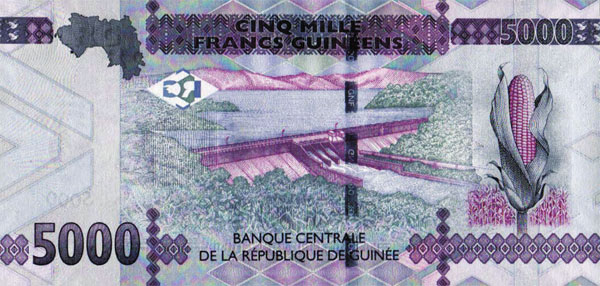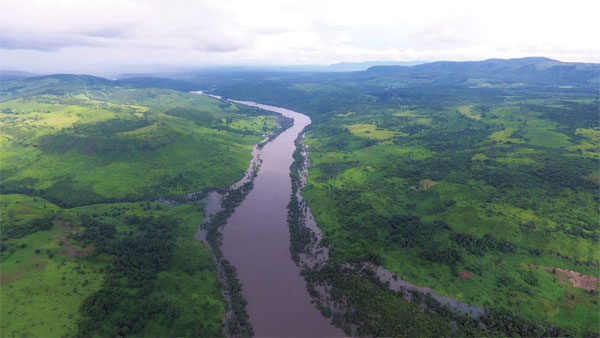Guinea: From Water Tower to Power Tower
By Hu Yifeng
[Guinea] Foromo Denis Sagno
Banknotes are often regarded as a nation’s “business card”,
reflecting the social culture and an important medium for displaying
the national image. Therefore, the designs for national currency notes
are always selected with particular care.

In Guinea, the largest denomination note, the 20,000 Guinean franc note, displays on its back the Kaleta hydropower station built by a Chinese company. When the note was issued, the hydropower station was still in the final stage of its construction. This was a first in Guinea and rare in the world.

The back of a 20,000 Guinean franc note displaying the Kaleta hydropower station
Interestingly, another hydropower station appears on the back of the 5,000 Guinean franc note. It is the Kinkon hydropower station that China built in the 1960s, the first hydropower station in Guinea after it became independent in 1958.
Guinea is known as the “water tower” of West Africa. For more than half a century, China and Guinea have worked together for the development of the latter’s hydropower industry to transform the water tower of West Africa into a power tower.

The back of a 5,000 Guinean franc note displaying the Kinkon hydropower station
Turning West Africa’s “Water Tower” into “Power Tower”
Guinea, the birthplace of the three main rivers in West Africa, the Niger, Senegal and Gambia, has the potential to generate at least 6,000 MW of hydropower. Hydropower has been a dream of generations of Guineans. However, due to the weak economic foundation and the lack of large-scale development, the harnessing of water resources remained low for a long time.
In the past, Guinea suffered from an acute shortage of electricity. Even in capital Conakry, it was common to have power outages dozens of times a day. The situation greatly improved after the completion of the Kaleta hydropower station in 2015. It has not only solved the power shortage in Conakry but is also supplying electricity directly to the surrounding areas. Conakry has also seen a boom in home appliance purchases, with some shops running out of their stock of television sets and refrigerators.
The lives of ordinary people have changed a lot. In the past, Kama, a local villager, would go to bed early in the evening. Now he has a television and a music system, and often watches live football matches with his friends, cheering his team. On the weekend, he goes to parties with other villagers, singing and dancing in the lit-up square.

The beautiful Konkouré River
He still gets excited when he talks about the hydropower station’s opening ceremony. On that day, traditional Guinean music echoed over the Kaleta hydropower station with people singing and dancing with it. “Our President and many leaders, ministers and ambassadors from China and a dozen of African countries attended the ceremony. More than 2,000 people were there!” Kama recalled with excitement.
As early as the 1900s, Guinea hoped to build a hydropower station at Kaleta, but was not able to do so for a long time until China came to its help. Now, its century-old dream has come true.
Merry Music by the Konkouré River
The Kaleta hydropower station being Guinea’s first major hydropower project, the technicians had no previous experience to guide them.
“I’ve been working for the hydropower station on the Konkouré River for many years. When the Chinese technicians came to do a field survey, I was their guide. At that time, no one believed that such a large hydropower station could be built on the river,” the chief of a local village said.
He was not exaggerating. Many unexpected difficulties sprang up during construction.
The first was how to transport people and materials to the construction site.
At first, there was only a dirt road from Conakry to the site. But a river, more than 200 meters wide, ran through the middle of the road, which meant people had to rely on ferries to cross it. Once the project started, the first thing that needed to be done was to build a road and bridge to open up a commuting line, so that large equipment, materials and personnel could reach the site smoothly.
Less than half a month after the project began, a temporary Bailey bridge was built and the potholed road turned into a wide and even road. It not only made things convenient for the project work but also facilitated the local people. With the newly built road, goods such as crops, bananas and charcoal began to be easily transported to Conakry, Dubreka and other big cities to be sold there and the villagers’ incomes increased. They went to the project site to express their gratitude to the “Chinese friends” with local songs and dances.
The lack of construction materials was another major problem.

A panoramic view of the Kaleta hydropower station
The local industrial base was relatively weak and there were only four cement factories. Also, most of the equipment and materials had to be purchased from abroad. The builder of the project, China International Water & Electric Corp., a subsidiary of China Three Gorges Corporation, mobilized its global supplier network and quickly completed the procurement, ensuring the progress of the project.
The third difficulty was the high technical requirements and complex construction environment.
In addition to the main task of building the hydropower station, the project also included urban and rural power grid reconstruction, a substation and transmission line construction, highway and bridge construction and other projects involving a river dam construction, water diversion, power generation, transformation and transmission to households. The 160-kilometer construction area had a complex environment, from sparsely populated tropical forests to numerous villages, then to the densely populated capital.
But no pains, no gains. The project team overcame the difficulties by dint of sheer hard work and the entire project was completed on schedule.
Never Giving up, Even in the Face of Death
The builders had to face not only the problems in the construction process but also harsh working conditions and even the threat of deadly epidemics.
Guinea is swelteringly hot in summer and the Chinese builders sweated it out in the red land of the distant country. After the end of work each day, their overalls would be soaked in sweat.
Malaria was another ordeal they had to endure. During the project, more than 95 percent of the Chinese employees suffered from malaria in varying degrees, and some even suffered from multiple bouts in succession.
But even more alarming than malaria was the threat of Ebola. In early 2014, the Ebola virus was first detected and confirmed in Guinea. As the number of Ebola infections and deaths continued to rise, many countries in West Africa were gripped by fear. Foreign-funded enterprises in Guinea evacuated, and some airlines grounded their Guinea flights.
Despite the severity of the epidemic, the Chinese workers continued to build the Kaleta hydropower station. They were among the few foreigners who did not leave Guinea during the Ebola epidemic.
A Guinean worker who participated in site construction vividly remembers those days. He said, “I will never forget the Chinese who still carried on building the power station and sticking to their posts. They were not scared of the virus. They didn’t give up on us.”
The work on the hydropower project withstood malaria and Ebola, moving forward methodically. The result was that the power station went into operation six months ahead of schedule. Commissioning of power transmission and transformation finished earlier than the power station, solving the problem of power transmission ahead of time.
It is this sense of responsibility and mission spirit of perseverance that has enabled Chinese enterprises to win the praise of the Guinean government and the people. There is an old saying in China that “there is more joy in sharing than enjoying alone”. While building the hydropower station, the project team also actively engaged in public welfare services for the local people.

The Kaleta hydropower station, a symphony of future development
With the help of the Chinese friends, Guinea, the water tower of West Africa, is becoming a veritable power tower. The hydropower stations have injected a strong impetus into the economic development of Guinea, and even West Africa.
From the construction of the Kinkon hydropower station to the Kaleta hydropower station, the Chinese have always worked hand in hand with the people of Guinea to fulfill their dream, turning Guinea into an energy-rich country. The two hydropower stations are like two monuments of friendship, illuminating Guinea’s night sky with inexhaustible electricity and providing hope for Guinea’s future development.
FOR MORE
Project Overview
Till date, China has supported Guinea in building several hydropower stations.
The Kaleta hydropower station is a major energy project developed by the Guinean government. The main project consisted of building a hydropower station with a total installed capacity of 240,000 kW and erecting a 225-kV transmission and transformation line. It was built by China International Water and Electric Corp., a subsidiary of China Three Gorges Corp., and put into operation in 2015 after three years of construction.
The installed capacity of the Kaleta hydropower station is equivalent to the total installed capacity of Guinea before the completion of the station. The operation of the power station doubled the number of operable installed units in Guinea, directly benefiting at least 4 million people, or one-third of Guinea’s total population.
The Kinkon hydropower station is a seasonally regulated reservoir diversion power project located in Pita District, upstream of Kinkon Falls on the Kokoulo River. It was built by China with construction beginning in 1963 and completed in 1966. Thanks to the first major overhaul in 1988 and the second major overhaul (transformation) in 2006, the station’s capacity expanded to 4x850 kW with an average annual generation of 16x106 kWh.


